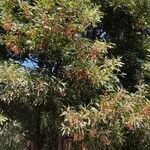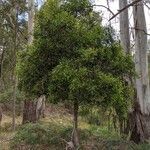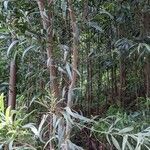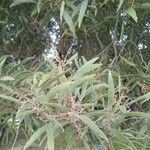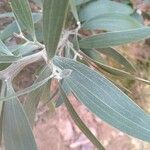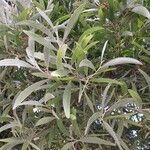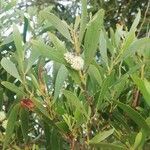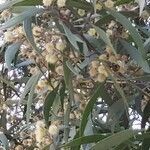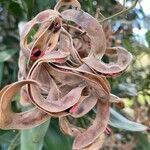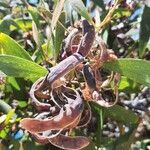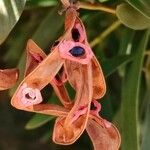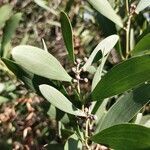Tree 6–30 (–45) m high; sometimes a shrub 1.5–3 m high; may spread by root suckers; bipinnate leaves often persist on young plants. Bark hard, fissured and somewhat scaly. Branchlets angular at extremities, ribbed, glabrous, rarely puberulous. Phyllodes narrowly elliptic, lanceolate or oblanceolate, often inequilateral, straight to ± falcate, 4–16 cm long, 6–30 mm wide, obtuse to acute, ± coriaceous, dark green, glabrous, with 3–5 main veins and prominently reticulate in between (vein islands ± rectangular). Inflorescences comprising mostly 3–5-headed racemes; raceme axes 6–40 mm long; peduncles 4–13 mm long, glabrous or puberulous; heads globular, 6 mm diam., 30–56-flowered, creamy pale yellow to white. Flowers 5‑merous; sepals ¾ or more united. Pods strongly curved to openly coiled and often twisted, to 15 cm long, 3.5–8 mm wide, coriaceous to subwoody, glabrous. Seeds longitudinal, broadly elliptic, 3–5 mm long, glossy, black; funicle fleshy, pink to deep red, twice-encircling seed.
An evergreen tree. It grows to a height of 30 m. It has a spread of 4-12 m. The stem is erect. The branches are spreading. They are angular. The bark is rough and furrowed. The foliage is often dark green and silvery. Young plants can have feathery true leaves. The leaves (phyllodes-leaf stems like leaves) are greyish green and slightly curved. They have rounded ends. There are 3-6 veins running along the leaf. The leaves are 7-20 cm long and tapered being broadest in the centre and more narrow near each end. The flowers are pale yellow balls. They are 1 cm across. The pods are curved sometimes into a complete circle. The pods are flat. The seeds are black and shiny. The seeds are bright orange where they join the pod.
Tree, 5-20 m high. Branches angular, glabrous or tips finely hairy when young. Leaves phyllodia, apparently simple, greyish turning dark, dull green, glabrous, linear-lanceolate to oblanceolate, 60-120 x 6-12 mm, straight to falcate, narrowed basally, 3-7 prominent longitudinal veins, young plants or coppice shoots may have bipinnate lamina at apex of phyllodia. Flowers globular heads solitary or in short axillary racemes, pale yellow to whitish. Flowering time Aug., Sept. Pod reddish brown, 50-150 x 6-8 mm, twisted, flattened, margins thickened, apex acute, dehiscent; seed funicle thickened, pink-red.
Resprouting shrub or tree to 35 m. Phyllodes linear-oblanceolate, with 3-7, longitudinal veins, dull dark green. Flowers in globose heads, pale yellow. Pods flat, straight or variously coiled, not constricted between seeds.
Glomerules in axillary racemes. Pods coiled.
